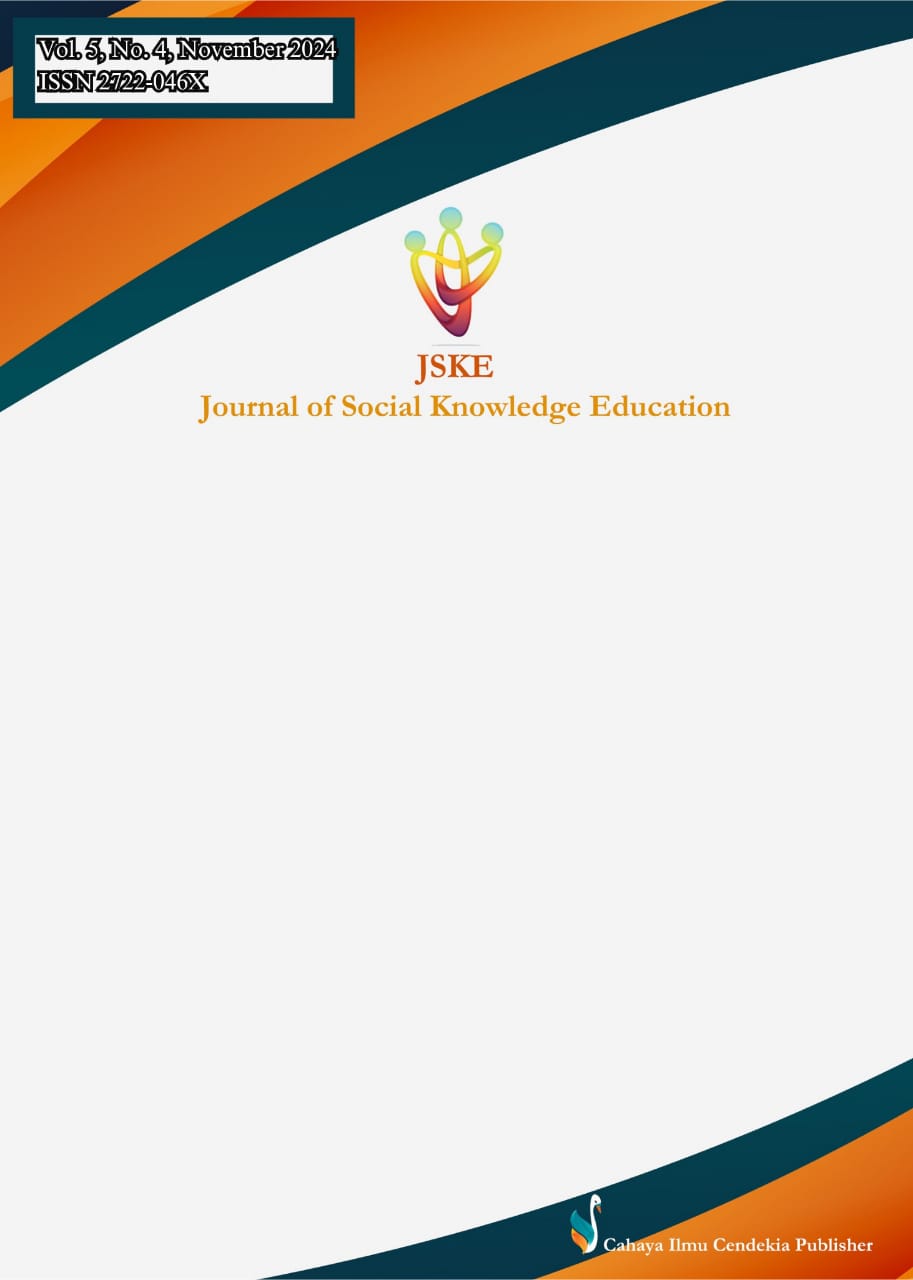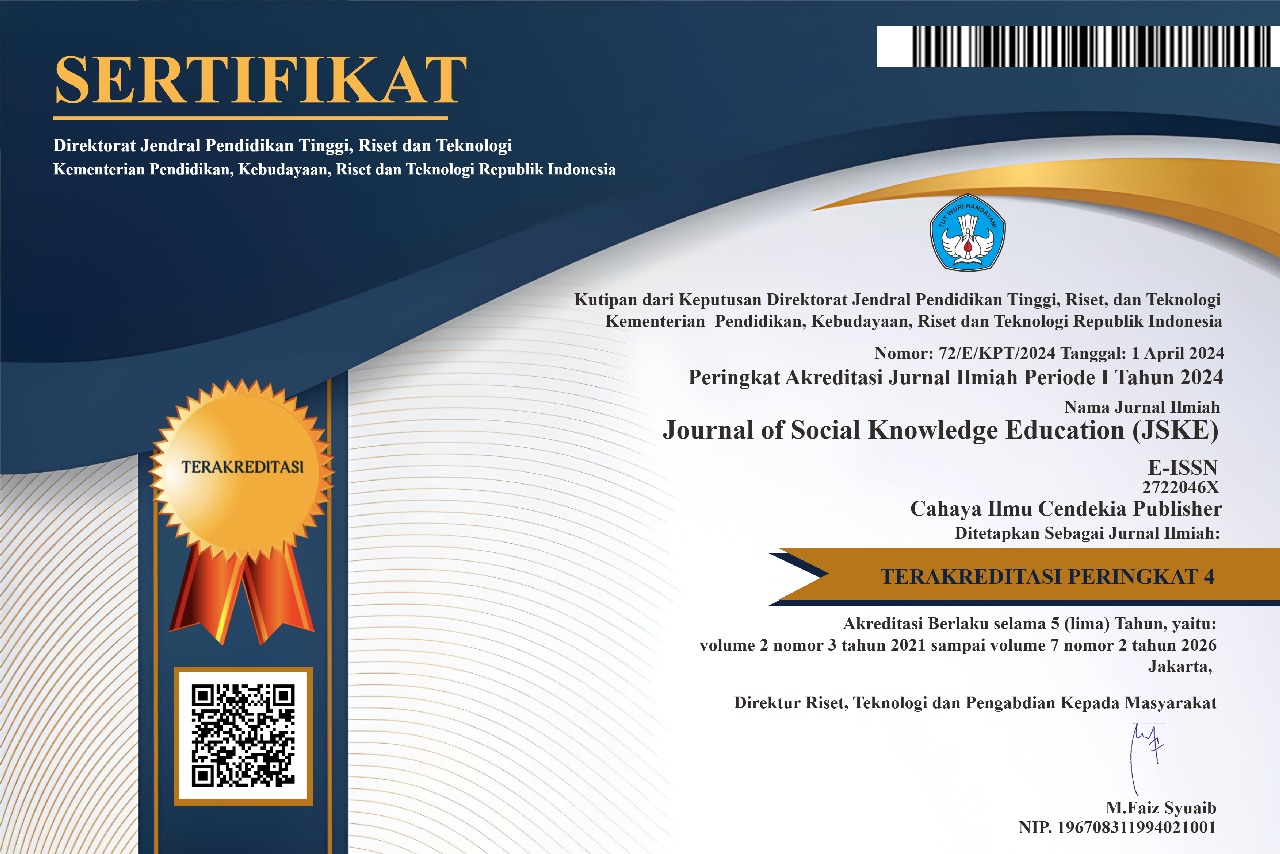Optimization of Shift Learning System: Its Impact on History Subject Students in Grade XI
Abstract
Purpose of the study: The aim of this study is to examine the impact of the shift learning system on the learning outcomes, motivation, and understanding of history subject students in Grade XI at State Senior High School 6, Bengkulu City.
Methodology: This study used a qualitative method with a descriptive approach. Data were collected through structured and unstructured interviews, observations, and document reviews. Tools included notebooks, audio recorders, and cameras for documentation. The data analysis followed a four-step process: data collection, reduction, presentation, and verification. No specific software was mentioned for data processing.
Main Findings: The shift learning system improves teacher-student interactions and creates a more focused learning environment. Students report better comprehension in smaller classes, while teachers find class management easier. However, challenges include increased teacher workload, uneven understanding due to shorter sessions, and difficulty for some students in adapting to independent tasks. Lecture methods remain effective but may cause boredom among students.
Novelty/Originality of this study: This study uniquely explores the specific impact of the shift learning system on history education for Grade XI students in Bengkulu City, focusing on teacher-student interactions, learning outcomes, and material comprehension. It provides new insights into adapting teaching methods in resource-limited settings and offers a local perspective that can guide similar educational policies elsewhere.
References
S. Hasibuan, C. T. Chu, and W. A. Godh, “Enhancing Creative Thinking in Circle Topics through the Realistic Mathematics Learning Approach,” Interval Indones. J. Math. Educ., vol. 2, no. 2, pp. 52–60, 2024, doi: 10.37251/ijome.v2i2.1148.
Zakiyah, K. Boonma, and R. Collado, “Physics Learning Innovation : Song and Animation-Based Media as a Learning Solution for Mirrors and Lenses for Junior High School Students,” J. Educ. Technol. Learn. Creat., vol. 2, no. 2, pp. 54–62, 2024, doi: 10.37251/jetlc.v2i2.1062.
M. B. M and A. N. G. Adeshina, “Exploring the Effectiveness of Moodle Activities in Enhancing EFL Learning for Yemeni Teachers,” Interval Indones. J. Math. Educ., vol. 8, no. 07, pp. 4177–4187, 2024, doi: 10.18535/sshj.v8i07.1183.
H. Amelia and R. Yosintha, “The use of breakout rooms discussion in jigsaw online learning class: developing creativity and increasing student engagement,” ELTR J., vol. 6, no. 2, pp. 86–95, 2022, doi: 10.37147/eltr.v6i2.149.
E. F. M. Jr, “Enhancing Student Learning Motivation in Physics Through Interactive Physics Education Technology ( PhET ) Simulation,” SchrödingerJournal Phys. Educ., vol. 5, no. 3, 2024, doi: 10.37251/sjpe.v5i3.1025.
S. Wulandari, “Pengaruh Penggunaan Metode Drill Terhadap Kemampuan Menggali Informasi dari Dongeng Peserta Didik Kelas II Sekolah Dasar,” J. Basic Educ. Res., vol. 1, no. 1, pp. 01–06, 2020, doi: 10.37251/jber.v1i1.6.
S. Subhan, K. Thongkaew, and L. I. Digbun, “Batetannga Village Community, Binuang District, Polewali Mandar Regency: The Value of Responsible Character Education in Sibali-Sipatambak Culture,” J. Soc. Knowl. Educ., vol. 5, no. 1, pp. 21–28, 2024, doi: 10.37251/jske.v5i1.889.
M. H. Khoiruddin, Z. Hazmi, Z. Baharin, M. S. Kaka, and S. Saenpich, “Development of visual novel games as learning media for the history of Indonesia ’ s independence,” J. Educ. Technol. Learn. Creat., vol. 1, no. 1, pp. 33–41, 2023, doi: 10.37251/jetlc.v1i1.622.
L. C. Dessi and M. Shah, “Application of the Numbered Head Together Type Cooperative Learning Model to Improve Student Learning Outcomes in Mathematics Subjects,” Interval Indones. J. Math. Educ., vol. 1, no. 2, pp. 67–72, 2023, doi: 10.37251/ijome.v1i2.773.
N. K. S. Febriyanti and M. Putra, “Mathematics learning interest of elementary school students in using metaphorical thinking learning model,” J. Educ. Technol., vol. 4, no. 3, p. 273, 2020, doi: 10.23887/jet.v4i3.26144.
Dea Agetia Noviana and Marudut Bernadtua Simanjuntak, “Representation of The Impact Of Social Gap That Affects Moral Values In The Film ‘Parasite,’” Lit. Int. Sci. Journals Soc. Educ. Humanit., vol. 1, no. 2, pp. 69–82, 2022, doi: 10.56910/literacy.v1i2.216.
Y. Sun, Y. Yang, N. Huang, and X. Zou, “The impacts of climate change risks on financial performance of mining industry: Evidence from listed companies in China,” Resour. Policy, vol. 69, no. April, 2020, doi: 10.1016/j.resourpol.2020.101828.
S. Fawzy, A. I. Osman, J. Doran, and D. W. Rooney, “Strategies for mitigation of climate change : a review Intergovernmental Panel on Climate Change,” Environ. Chem. Lett., vol. 18, no. 6, pp. 2069–2094, 2020, doi: 10.1007/s10311-020-01059-w.
C. R. Schneider, L. Zaval, and E. M. Markowitz, “Positive emotions and climate change,” COBEHA, vol. 42, pp. 114–120, 2021, doi: 10.1016/j.cobeha.2021.04.009.
D. Tsoy, T. Tirasawasdichai, and K. Ivanovich Kurpayanidi, “Role of Social Media in Shaping Public Risk Perception during COVID-19 Pandemic: A Theoretical Review,” Int. J. Manag. Sci. Bus. Adm., vol. 7, no. 2, pp. 35–41, 2021, doi: 10.18775/ijmsba.1849-5664-5419.2014.72.1005.
M. C. Schippers, “For the Greater Good? The Devastating Ripple Effects of the Covid-19 Crisis,” Frontiers in Psychology, vol. 11, no. September. pp. 1–13, 2020. doi: 10.3389/fpsyg.2020.577740.
A. Naddeo, R. Califano, and I. Fiorillo, “Identifying factors that influenced wellbeing and learning effectiveness during the sudden transition into eLearning due to the COVID-19 lockdown,” Work, vol. 68, no. 1, pp. 45–67, 2021, doi: 10.3233/WOR-203358.
R. H. Chen, “Effects of Deliberate Practice on Blended Learning Sustainability: A Community of Inquiry Perspective,” Sustain., vol. 14, no. 3, 2022, doi: 10.3390/su14031785.
S. Schweder and D. Raufelder, “Adolescents’ expectancy–value profiles in school context: The impact of self-directed learning intervals,” J. Adolesc., vol. 94, no. 4, pp. 569–586, 2022, doi: 10.1002/jad.12047.
Y. T. Jou, K. A. Mariñas, and C. S. Saflor, “Assessing Cognitive Factors of Modular Distance Learning of K‐12 Students Amidst the COVID‐19 Pandemic towards Academic Achievements and Satisfaction,” Behav. Sci. (Basel)., vol. 12, no. 7, 2022, doi: 10.3390/bs12070200.
A. W. Irawan, D. Dwisona, and M. Lestari, “Psychological Impacts of Students on Online Learning During the Pandemic COVID-19,” KONSELI J. Bimbing. dan Konseling, vol. 7, no. 1, pp. 53–60, 2020, doi: 10.24042/kons.v7i1.6389.
S. Ivaldi, G. Scaratti, and E. Fregnan, “Dwelling within the fourth industrial revolution: organizational learning for new competences, processes and work cultures,” J. Work. Learn., vol. 34, no. 1, pp. 1–26, 2022, doi: 10.1108/JWL-07-2020-0127.
R. W. Anitasari and R. D. Utami, “Implementasi Media Articulate Storyline dalam Pembelajaran sebagai Penunjang Pelaksanaan Kurikulum 2013 di Sekolah Dasar,” J. Basicedu, vol. 6, no. 4, pp. 5926–5935, 2022, doi: 10.31004/basicedu.v6i4.3167.
F. Isroani, N. Jaafar, and M. Muflihaini, “Effectiveness of E-Learning Learning to Improve Student Learning Outcomes at Madrasah Aliyah,” Int. J. Sci. Educ. Cult. Stud., vol. 1, no. 1, pp. 42–51, 2022, doi: 10.58291/ijsecs.v1i1.26.
B. Verplanken and S. Orbell, Attitudes , Habits , and Behavior Change. 2022.
Y. Suprapto, N. Pambudiyatno, M. Maharani Sukma, B. Bagus Harianto, and A. Irfansyah, “Improving Learning Outcomes Through Interactive Learning Media Based on Macromedia Flash,” in Proceeding of International Conference of Advance Transportation, Engineering, and Applied Social Science, 2023, pp. 1001–1005. doi: 10.46491/icateas.v2i1.1773.
M. A. Lasaiba, “the Effectiveness of the 5E Learning Cycle Model As an Effort To Optimize Students’ Activities and Learning Outcomes,” Edu Sci. J., vol. 4, no. 1, pp. 11–21, 2023, doi: 10.30598/edusciencesvol4iss1pp11-21.
A. Fikri, M. Mahdum, and I. Isjoni, “The Development of Local History Learning Model Based on Progressivism to Promote Historical Thinking Skills,” Ta’dib, vol. 25, no. 1, p. 105, 2022, doi: 10.31958/jt.v25i1.5831.
D. Ortega-Sánchez, J. P. Blanch, and C. Pérez-González, “Emotions and construction of national identities in historical education,” Educ. Sci., vol. 10, no. 11, pp. 1–12, 2020, doi: 10.3390/educsci10110322.
D. Al Maani and Z. Shanti, “Technology-Enhanced Learning in Light of Bloom’s Taxonomy: A Student-Experience Study of the History of Architecture Course,” Sustain., vol. 15, no. 3, 2023, doi: 10.3390/su15032624.
D. Mohinur and U. Rahimjon, “a Study of Memory Processes and Their Development in Preschool,” Uzb. Sch. J., vol. 05, pp. 62–65, 2022, [Online]. Available: www.uzbekscholar.com
S. Qiu et al., “Development and validation of an interpretable deep learning framework for Alzheimer’s disease classification,” Brain, vol. 143, no. 6, pp. 1920–1933, 2020, doi: 10.1093/brain/awaa137.
G. Syahputra and A. J. Edwards, “Transforming History Teaching: Using Adobe Photoshop E-Posters to Teach the Battle of November 10, 1945,” J. Educ. Technol. Learn. Creat., vol. 2, no. 1, pp. 29–40, 2024, doi: 10.37251/jetlc.v2i1.980.
T. N. Fitria, “Using Canva As Media for English Language Teaching (Elt) in Developing Creativity for Informatics Students’,” ELT Echo J. English Lang. Teach. Foreign Lang. Context, vol. 7, no. 1, p. 58, 2022, doi: 10.24235/eltecho.v7i1.10789.
C. Attard and K. Holmes, “An exploration of teacher and student perceptions of blended learning in four secondary mathematics classrooms,” Math. Educ. Res. J., vol. 34, no. 4, pp. 719–740, 2022, doi: 10.1007/s13394-020-00359-2.
J. Setiawan, Aman, and T. Wulandari, “Understanding Indonesian history, interest in learning history and national insight with nationalism attitude,” Int. J. Eval. Res. Educ., vol. 9, no. 2, pp. 364–373, 2020, doi: 10.11591/ijere.v9i2.20474.
Copyright (c) 2024 Eka Saputra, Trần Ngọc Dũng

This work is licensed under a Creative Commons Attribution 4.0 International License.
Authors who publish with this journal agree to the following terms:
- Authors retain copyright and acknowledge that the Journal of social knowledge education (JSKE) is the first publisher licensed under a Creative Commons Attribution 4.0 International License.
- Authors are able to enter into separate, additional contractual arrangements for the non-exclusive distribution of the journal's published version of the work (e.g., post it to an institutional repository or publish it in a book), with an acknowledgment of its initial publication in this journal.
- Authors are permitted and encouraged to post their work online (e.g., in institutional repositories or on their website) prior to and during the submission process, as it can lead to productive exchanges and earlier and greater citation of published work.







.png)
.png)















